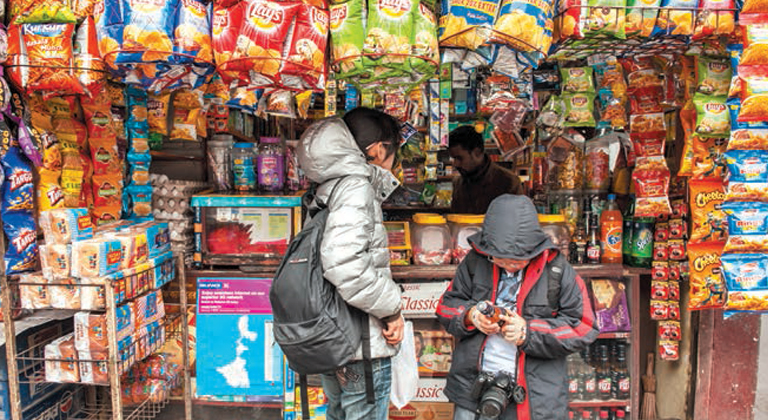E-commerce in Retail
Biz@India
February 2016
After making waves in the merchandise segment, e-commerce has now shifted to grocery, including fresh vegetables and perishables. The potential exists but comes with its own set of challenges, which many of the players are blind to.
Home delivery is definitely not a new term in India. For decades, grocers, restaurateurs, vegetable vendors and even pharmacies have been delivering at home the orders as low as INR 20 (about 35 cents), the price of a small bottle of Coca Cola, for example.
In the past, it has been through telephone that the orders were placed and merchandise delivered and normally it was with a network of shops of the neighbourhood and where the relationships were extremely personal and intimate.
About five years ago, with the advent of e-commerce, the concept of home delivery received a total overhaul when the base of suppliers was expanded to a whole new range of vendors, who more often than not hailed from an entirely different part of the country and who had no contact with or even knowledge of the customers.
With little customer intimacy, it was sure that e-commerce would be full of pitfalls, none of them which ever plagued the neighbourhood store. The problems for e-commerce range from a total lack of customer loyalty as the vendor remains often an unknown, practically irrelevant part of the deal. The other issues were very high rate of returns, propelled by the practice of cash on delivery which meant that a buyer felt no compulsion to keep his part of the deal when the goods, very often heavy furniture or large domestic appliances turned up at the doorstep.
These hurdles did not seem to bother investors as five years ago India witnessed the first rush of investors and companies in the electronic retail or e-tail domain, with the rapid rise of dozens of home grown companies like Flipkart and Snapdeal, in addition to the arrival of global giants like Amazon. Their rise was in large part thanks to numerous venture capitalists, pumping in billions of dollars, in the hope that the sector was the new El Dorado of the Indian economy.
The e-commerce revolution was fuelled largely due to the sharp spike in the smartphone market of India, which recorded the world’s fastest growth in smartphone acquisition, with total number of smartphones crossing the 350 million mark by the end of 2014. And, especially encouraging for the e-commerce firms, the share of purchases made by Indian consumers through their smartphones had risen smartly between 2012 and 2014.
Currently, the e-commerce market is estimated to be USD 16 billion, of which e-tail remains a very small percentage, while over three-fourth of the business is travel related, with airline and hotel bookings taking a major share of the same. However, e-tail is the fastest growing and most high profile e-commerce activity that seems to have gripped the imagination of the country. The e-tail in India is largely a marketplace model and according to experts, it is easily scalable and requires proportionately lower capital and time.
Pragya Singh, vice president, Technopak, a consultancy firm, says that food and grocery contribute nearly two thirds to the overall retail market in India, valued at about USD 600 billion last year. She goes on to say that as the e-tail is still at a very early stage, companies have been focusing on growing their revenues and gross merchandise value rather than being profitable. “They have been keen on developing a nationwide footprint and to show topline growth to keep their investors happy, rather than looking at their bottomline. To increase sales, they have been often very aggressive with their discounted prices,” she says.
She further adds that e-tail companies have been replicating the role of distributor/wholesaler and the retailer. Often, they also act like a logistics company, picking goods from a particular store and delivering it to the customer. In this case again, the margins are under tremendous pressure. Unable to handle topline driven business model, many of the players in the merchandise segment have already run into problems and the sector has seen some significant consolidation, with the market leaders like Flipkart and Snapdeal going out for agressive acquistions.
Singh says that some consolidation has already taken place in the e-tail business and now the field has been reduced to about half a dozen serious players, with adequate size and market penetration, with more than a dozen smaller players having disappeared.
Milk through mobile
Now, a very similar phenomenon is being repeated with the e-commerce in grocery market. The last 12 months have seen a sudden emergence of nearly a dozen companies that offer online purchase and delivery of everyday groceries needed at home, ranging from detergents and shampoos to vegetables, eggs and bread.
Technopak’s Pragya Singh says that a lot of changes have occurred in the grocery market with the sudden rush of investors and players, even though grocery accounted for less than one pc of the USD 7 billion retail e-commerce market in the country in 2014.
The biggest kid on the block is Big Basket, which launched operations in 2011. The firm raised USD 61million from private equity funds – Ascent Capital, Helion Ventures, Zodius and US-based Bessemer Venture Partners. It claims a customer base of about 500,000 and says that topline growth is 12 to 16 pc each month. It is targetting sales of USD 126 million in the current fiscal, as against USD 33 million last year. Big Basket says it expects to reach USD 295 million in the fiscal 2017.
Another player, Localbanya, which started operations in Mumbai three years ago, operates in five cities, as does Zopnow, based in Bangalore. Investors such as Sequoia Capital, Saif Capital Partners, and Tiger Capital Partners are also backing other young on-demand grocery delivery services. They use mobile phone apps to link consumers to local stores, including independent mom-and-pop shops, and handle deliveries for online orders.
Technopak’s Singh adds that one of the main reasons behind the emergence of online players in grocery business could be the failure of the organised sector to take a significant part of the market. “Due to the infrastructural problems, transport hurdles as well as extremely high cost involved in the real estate, organised retail in food and grocery is still less than 5 pc, while the overwhelming majority is in the hands of small to very small format corner stores referred to as kirana in India. This gives an opportunity to the development of e-tail in grocery to fill up some of the gaps in the market,” she says.
As a result, number of new players like Grophers, Localbanya as well as established e-commerce players like Flipkart and Amazon and also the traditional brick and mortar large format retail stores like Reliance, Big Bazaar and Tata have gotten into the market, trying to fill in the gaps.
The traditional brick and mortars have an edge over the newcomers and pure play online grocery stores. Their main advantages lie in brand recognition and moreover their existing stores can be leveraged for fulfilment and they also have an existing, captive client base.

Traditional mom-and-pop shops have an advantage over the online grocery stores as they tend to build a personal relationship with their clients
Singh says that even though the market valuations of the newcomers in the e-grocery business have not yet gone through the roof, unlike the broader e-commerce players, who have fattened on billions of dollars invested by venture capitalists and who have been turning out steep losses on the back of their policy of deep discounting and driving topline growth, without bothering about profitability as they keep expanding their network horizontally as well as vertically.
Aggressive growth ahead
The same phenomenon is set to be repeated in the e-grocery space as companies set extremely aggressive growth targets that are unrealistic and will push them on the same path as companies in the e-commerce space.
“What the companies need to really focus on is to develop their business and fine tune their model by perfecting it in one city. Their long-term health will depend on how they handle the accuracy of the delivery and the timeliness. No customer would accept if, for instance, the company forgets to send some of the items, or not have the right brand and in the right form of packaging as customers would not want to change their brand or accept products which may look damaged,” says Singh.
“It’s a very low margin business that involves a complex supply chain, needs quick fulfilment as no one will wait for three-four days for the grocery supplies. In addition, the companies have to be sure that they meet the taste requirements of the customers, while being able to face very, very high competition from neighbourhood grocery stores, which build a personal relationship with their clients and also offer home delivery, that too almost instantaneously. The customers would expect everything that they used to get from their local stores and refuse to pay any premium,” points out Singh.
Another challenge for these companies is to handle the perishable goods like fresh vegetables, milk or milk products and frozen goods so that not only they reach the customer in a good shape but are also brought back in a good condition in case of returns.
So, consolidation is set to be repeated in e-grocery business as well, even though it is still in the early days. Yet the market in e-grocery could perhaps have more players, as the market is more localised than national. Singh estimates that a shakeout could come in the next three-four years. The local stores may eventually not be impacted negatively as the current business model of many of the e-grocers involve developing a network of local grocery stores for their own business, so some of the stores may end up getting additional orders without any additional effort or expense on their part.
By late last year, the first signs of severe stress in the e-grocery business became visible as many of the companies slowed down their hitherto aggressive growth, with even leaders like Gorfers shutting down operations in several of the tier II cities where they had begun operations just a few months earlier. The decision to pull out of Bhopal, Bhubaneswar, Coimbatore, Kochi, Ludhiana, Mysuru, Nashik, Rajkot, and Visakhapatnam – all major cities in their respective states, “was just a regular decision to not focus on areas where we were not seeing a significant number of transactions,’’ Grofers co-founder Albinder Dhindsa told media. “We have shut down cities and categories in the past as well and will continue to do it if it makes sense for the business,” Dhindsa said. Grofers still operates in 17 cities throughout India.
Kishore Biyani, chief executive officer of Future Retail Ltd, which operates hypermarket and retail chains such as Big Bazaar, Food Bazaar and FBB, is harsher in his predictions about the fate of the online rivals. “None of the existing online grocers will survive. They will shut shop one after another. Their model doesn’t make economic sense at all,” Biyani told media in Mumbai in January.
Some others are slightly less pessimistic. “You will see consolidation with 10-15 companies at present in the space coming down to about two-three companies in the next 24 months,” said Anil Talreja, partner, Deloitte Haskins and Sells LLP, a consulting firm, while explaining that the business will survive and find takers as traditionally Indians are used to having multiple vendors coming to their doorstep for delivery of fruits, vegetables and groceries. Over time this habit will be replaced by apps and there will be one vendor delivering food and groceries to their doorstep.










